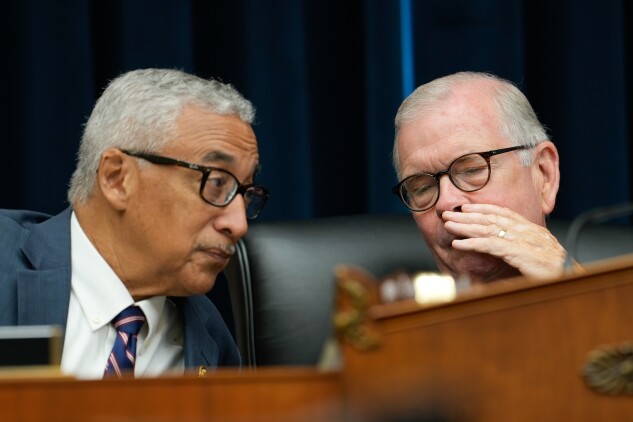Tuesday morning musings for workplace watchers
DOL Spared from Layoffs | Research Shows Heat Standards Help
Parker Purifoy: The Labor Department and the National Labor Relations Board appear to be untouched by the shutdown reductions-in-force announced last Friday by the Trump administration, according to workers within those agencies.
The DOL was supposed to see more resignations than layoffs this year: roughly 2,700 of its 14,578 employees agreed to voluntarily separate from the agency. Leadership has shown it also wants to maintain some staff: about 100 of those are being rescinded for “mission-critical roles.”
It also brought back some probationary employees terminated earlier this year as part of the Trump administration’s initial workforce cuts, and suspended layoffs for certain subagencies based on court order.
The NLRB, meanwhile, has mostly been mum on resignations, layoffs, or firings—though the labor board’s acting general counsel William Cowen in February said the agency was attempting to avoid mass layoffs.
Trump administration officials have blamed Democrats for the most-recent terminations at agencies like the departments of Commerce, Homeland Security, and Health and Human Services—as well as the shutdown generally.
Similar finger-pointing at Democrats for the lapse in appropriations appeared on some agency employees’ out-of-office emails and on government websites when the shutdown began Oct. 1.
“Due to the Radical Left Democrat shutdown, this government website will not be updated during the funding lapse,” said a notice on USDA’s website, along with auto-reply emails from furloughed Education Department employees that said “Democrat Senators are blocking” the appropriations bill.
The postings prompted House Democrats to request a Justice Department investigation, with Reps. Bobby Scott (D-Va.) and Jamie Raskin (D-Md.) alleging those partisan messages violate the Hatch Act.
Scott also asked Rep. Tim Walberg (R-Mich.), chair of the House Education and the Workforce Committee, to launch a committee probe and hold hearings on the agency messages.
Although none appeared on the DOL’s website, Labor Secretary Lori Chavez-DeRemer recently repeated the message that Democrats are responsible, using her official X account.
The Hatch Act restricts partisan activity in federal operations and protects employees from political interference in their work.
“The Trump Administration’s scheme to steal or at least borrow the identities of federal workers and conscript their office email accounts for partisan political purposes is a plain violation of this criminal statute,” Scott and Raskin said in their letter to DOJ Acting Assistant Attorney General Matthew Galeotti. “The only true mystery is not whether there was a criminal violation here but who committed it.”
The American Federation of Government Employees sued DOE for the emails, claiming the auto-replies were altered without permission from the furloughed workers.
Tre’Vaughn Howard: There are fewer workplace injuries when states create safety regulations to protect workers from the heat, two sets of researchers say.
Workplace safety researchers recently started breaking ground in unpacking the effects of heat on workers and how the implementation of a heat standard could reduce injuries caused by rising temperatures.
The studies’ exploration of the causal link between high heat temperatures and injuries in the workplace indicates heat regulations measurably reduce workplace injuries beyond exhaustion and heat strokes.
“Employers need to understand that there is a hidden cost of heat for them, workers, and society,” said Barrak Alahmad, one of the co-authors of the study done by Harvard T.H. Chan School of Public Health and George Washington University Milken Institute School of Public Health.
“If you only focus on heat strokes and heat exhaustion, you’re going to miss a lot from the total burden of heat—for employers this means absenteeism, reduction in productivity, turnover.”
The nationwide analysis revealed that injury risk rises when the heat index reaches around 85 degrees and increases sharply after 90 degrees; that the effect is seen across nearly all industry sectors; and that heat translated to a little over 1% of injuries in 2023.
Using California workers’ compensation claims, the Workers Compensation Research Institute solely focused on the state. WCRI determined the state’s implementation of a heat standard in 2005 led to a 15% reduction in work-related injuries on hot days.
“The hotter it gets outside, the more effective the heat standard appeared to be in reducing the frequency of injury,” said Sebastian Negrusa, one of the co-authors of the study.
The Trump administration extended the post-hearing comment period for the Biden-era heat proposal to October 30, and has indicated OSHA will issue a final rule.
The proposed rule has faced criticism from businesses that argue it’s too prescriptive. Industries that are likely to be affected, such as construction and warehousing, are pressuring OSHA to modify the proposed heat rule to a more performance-oriented approach rather than leave it in the hands of the next Democratic administration.
Nevada’s heat regulation, which began enforcement in April, has been cited by employers as the prime example for a more performance-based approach to addressing heat.
New Mexico is currently developing its own heat standard that would cover indoor and outdoor workplaces. If the rule is adopted, the state would join seven other states including California and Maryland in establishing a standard to protect workers from heat.
To contact the reporters on this story:
To contact the editors responsible for this story:
Learn more about Bloomberg Law or Log In to keep reading:
See Breaking News in Context
Bloomberg Law provides trusted coverage of current events enhanced with legal analysis.
Already a subscriber?
Log in to keep reading or access research tools and resources.


